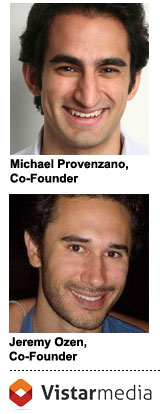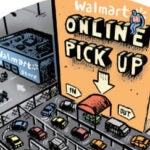 Jeremy Ozen and Michaael Provenzano are co-founders of Vistar Media. Along with former chief architect of Invite Media, Mark Chadwick, Ozen and Provenzano are the in the early stages of trying to crack the out-of-home (OOH) market with an exchange of sorts, and link it to the digital demand-side, which currently buys across PC-based display, mobile and video channels. The challenge: penetrate a traditional out-of-home market that has been caught in the Stone Age.
Jeremy Ozen and Michaael Provenzano are co-founders of Vistar Media. Along with former chief architect of Invite Media, Mark Chadwick, Ozen and Provenzano are the in the early stages of trying to crack the out-of-home (OOH) market with an exchange of sorts, and link it to the digital demand-side, which currently buys across PC-based display, mobile and video channels. The challenge: penetrate a traditional out-of-home market that has been caught in the Stone Age.
Provenzano and Ozen discussed their company with AdExchanger…
AdExchanger: What attracted you all to the out-of-home market?
JEREMY OZEN: For myself, initially, I was interested in why there weren’t more digital billboards, in general. It led me to reading about the rules that govern digital billboards and when you can and can’t install them – municipalities have many laws governing outside billboards. This led me to consider the [“indoor” digital out-of home market] where there is foot traffic in many indoor locations, and where government rules don’t dictate what you can do with a screen.
Michael and I were good friends in college, and Michael was the cofounder of Invite. So, it was a perfect time to take a shot at revolutionizing the DOOH (digital out-of-home) industry.
MICHAEL PROVENZANO: Back in March, 2011, we started looking into it and I’d add that the fact that no one else was in it and it was such an immature space that had clearly taken a lot of bad steps previously, made it very inviting to take on a huge problem. There’s so much inefficiency [in DOOH].
So, why is efficiency such a big problem in out-of-home?
MICHAEL PROVENZANO: The issue with digital out-of-home specifically was that people started with traditional out-of-home thinking. They said, “We will sell this like a piece of paper in a four‑week time period, because there’s a lot of work in printing something, sending someone out to the signage’s location, taking it down, …” – and that whole process.
What was weird was when out-of-home converted over to digital and people said to themselves, “Great. In one spot, we can now sell eight ads instead of one.” But they never changed their traditional out-of-home process and still managed yield the same as always.
This has prevented the DOOH industry from capturing digital budgets. It can’t really call itself a true digital medium today because it is continuing to be sold as a traditional, out-of-home media.
What is a typical use case for what you are planning for your platform, out of the gate?
MICHAEL PROVENZANO: In terms of use cases, it depends on which side of the game you are on – the media buying side or the publisher side.
From a media buying standpoint, our ad serving technology essentially duplicates what DoubleClick ad server does by validating where your ad is being served and when. That product is sold to people who already buy out-of-home media today. We are also giving them that level of compliance that they did not have before – when they would send out people with cameras to take pictures of ads being shown on screens. It’s absurd, because they’re paying people $4,000 a month to get DOOH ads validated. So that is one use case, general ad serving.
Now, jumping to the publisher side, there is the management of insertion orders and line items – the direct sales side. General ad serving would be on the publisher side, too, where we can address, “You sell X percent of your inventory. What do you do with the rest? What do you do with the unsold?”
What we have built is a way to monetize that remnant and to put it onto an exchange. And we have built a standard API to talk to all the places, publishers and their software that they might use.
Automatically, we not only can deliver ads into their system to facilitate ad serving. But we also can then facilitate filling their limited inventory. So that’s where the exchange product or use case comes into play. That brings us back to the demand side, where we have a real‑time exchange of place-based inventory floating around.
That is when we go out to the digital agencies. There are two digital sources of demand: digital agencies and their trading desks and then the programmatic buyers. Agencies and trading desks obviously log into our system just like someone would log into an Invite Media system or Turn or AppNexus, and they set up their insertion orders, targeting rules and then hit “go.” Then our bidder bids on our exchange.
The other side of that digital demand is the programmatic demand. That programmatic demand comes from video, mobile and even display DSPs (demand-side platforms). From the video programmatic standpoint, they can buy an online video on a PC, tablet, mobile device and a connected TV. With us, they can extend that onto another screen, which is digital place-based or digital out-of-home.
Where are the data sets for targeting that are available through your platform?
MICHAEL PROVENZANO: In terms of the data, things like geography – we get a latitude/longitude (lat/long) for ad requests. Every time someone calls our exchange, we know exactly where it is. The reason we do that on a per ad request basis is because some media like “Taxi” is mobile, so it’s good to have an updated lat/long every time around. That data comes directly from the device.
Then, there is “type” data. This tells me that the [DOOH placement] is a bar, restaurant or an office building. There’s also a lot of metadata from the different networks. Each of them has different feelings on how to share that data, but our goal is to expose as much as possible.
I’d like for us to be able to say that if you’re in a doctor’s office, we’ll be able to know whether it’s an orthopedic surgeon or an ophthalmologist, or you’re in an office building with elevators for finance companies or ad agencies.
There’s a lot of very rich, first‑party metadata. And then, there’s Nielsen data, of course. On all of the major networks that are audited by Nielsen, Nielsen provides traffic data and demographics such as age and gender.
JEREMY OZEN: The ability to know a “lat/long” and also the “type” outside of the first‑party datasets, lead to very interesting abilities to determine your likely audience. We see lots of solutions starting to percolate because there are very similar types of targeting that you would do if you’re buying mobile, for example.
We haven’t figured out the third‑party data at this point, but I can see having lots of interesting conversations with third‑party providers where you can start to target audience segments that sound very similar to the audience segments that you’d be targeting from mobile as well as online. You can start to see the definition of one audience segment, and then spreading it across multiple platforms.
How will you make money?
MICHAEL PROVENZANO: In a few ways. We’ll go by use case.
From an out-of-home buyer standpoint, it’s similar in the sense that we have an ad server for helping serve ads and doing the verification that your ad delivers to a certain place. We charge the out-of-home buyer a fee for that. We do not charge the publisher for that level of ad serving, where, let’s say, an out-of-home agency wants to run a campaign through us on a publisher’s network – their contract is still between the agency and the network. We don’t get between that relationship.
With the exchange marketplace, there’s a rev share with the publishers. What we’re doing is providing optimization, and we’re also bringing them something they never had – digital ad dollars.
Is Vistar Media in-market today – and what’s the plan for the rollout?
JEREMY OZEN: We are in-market and running our first campaign which started in early July. We’ve got another starting imminently. There are multiple angles to our roll out.
We’re continually rolling out new publishers and integrating them into our platform. Another part of the rollout is opening up the exchange to programmatic buyers as Michael pointed out. We’re working on that as we speak.
I think those are the key elements of rollout. Michael, is there anything you were going to add?
MICHAEL PROVENZANO: What’s exciting is we will be getting digital ad dollars that are going to be running through the system in addition to what we’re hoping is the majority of ad serving for the out-of-home home buys. It’s a no-brainer for people who are buying out-of-home today. I believe external bidders will be in place by mid Q4, but I hate putting a date on it.
Michael, what’s the connection between what you’re doing today and Invite Media?
MICHAEL PROVENZANO: From day one, there’s a lot of value in knowing so much about advertising in general due to my Invite days. The first thing we tried was re‑implementing an online ad server, for example. From that, we learned that this is a very unique industry for devices that have intermittent Internet connections. They have certain bandwidth requirements throughout the day.
We figured out we have to build a unique ad serving solution. So, with the other Vistar co‑founder, Mark Chadwick, who was the chief architect of Invite, we’ve been able to take the right steps from a product standpoint with very minimal error.
I think with most startups, especially with Invite, there are so many iterations of a product that was not the original product that we needed to build. At Invite, we were building a lot of things in the many months that weren’t directly in line with what our long‑term company was. With Vistar, there’s very little throwaway. Every step we take, it’s been very thought through.
We’ve been fortunate enough to have all the knowledge from the Invite days and understand the online ecosystem and how it evolves over time as well as all the hiccups that it might have had over that time. We’ve taken those learnings and applied it to a space where we have a fresh slate to build this ad ecosystem in what we hope will be the right way.
What’s the story with funding, and can you talk a little bit about how many people you are today and any plans on the scaling the human side to Vistar?
JEREMY OZEN: We raised a round earlier in 2012 with the other Invite co‑founders and investors and used that to build what we’ve created to-date. Our team now is the three co‑founders, me, Michael, and Mark, and an engineering team of five, and we have an intern.
The growth that we’d like to have going forward is on the account management platform side. In terms of funding, we think we’re in a pretty good spot and I’m starting to think about what we need to scale and hire in terms of people. We’ll use new capital to fund our growth plans some time in Q4.
Follow Vistar Media (@vistarmedia) and AdExchanger (@adexchanger) on Twitter.













